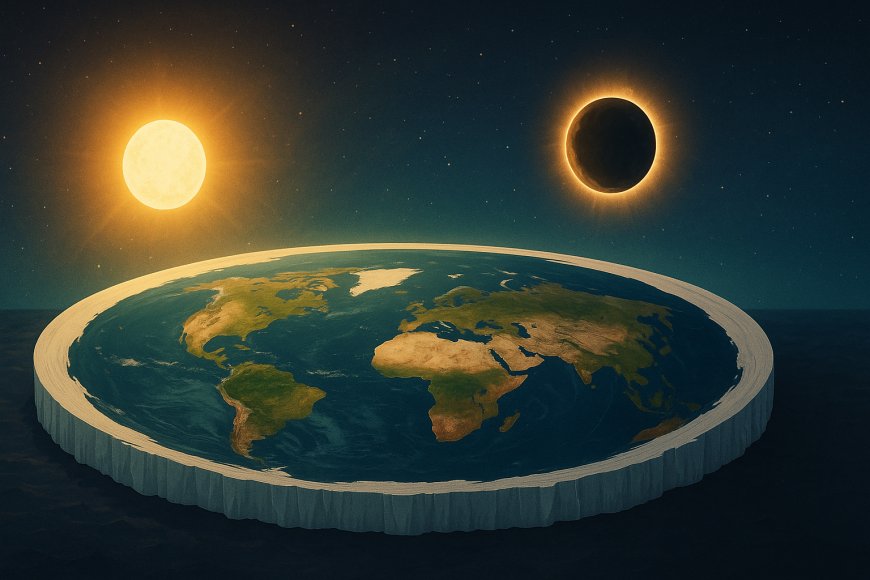Celestial Synchrony: How Eclipses on a Flat Earth Defy the Globe’s Shadow Narrative
This investigative piece explores how the mechanics of solar and lunar eclipses can be more logically interpreted through a flat Earth lens. By questioning the mainstream “Earth shadow” explanation and exploring alternative models—like the “shadow object” theory—this article unpacks what may be one of the most overlooked anomalies in heliocentric science.

As the moon turns red and the sun is temporarily veiled, millions gaze upward in awe, accepting the story they’ve always been told: that Earth's shadow causes these dramatic celestial events. But what if this widely accepted explanation doesn’t hold up under scrutiny?
For centuries, ancient civilizations observed eclipses without the aid of modern telescopes or space agencies—and many had vastly different interpretations. Flat Earth researchers are now reviving some of these models, not out of nostalgia, but because they may actually explain observable phenomena better than the globe theory.
🌕 The Lunar Eclipse Puzzle: Where’s the Earth?
Under the heliocentric model, lunar eclipses occur when Earth is precisely between the sun and moon, casting a shadow that darkens the lunar surface. But flat Earth proponents highlight strange cases of lunar eclipses occurring when both the sun and moon are visible in the sky, an impossibility if Earth is meant to be in between them.
Enter the "Shadow Object" theory—an unseen celestial body, sometimes referred to as the "Rahu" in ancient Indian astronomy, that passes in front of or behind the moon, causing the red hue. This theory fits far more neatly into the flat Earth model, where the sun and moon circle above the plane, rather than behind or under it.
☀️ Solar Eclipses and the Perfect Coincidence
In a globe model, the moon—though 400 times smaller than the sun—is coincidentally 400 times closer, allowing it to perfectly cover the sun during a total eclipse. Flat Earth researchers argue this cosmic coincidence stretches credulity. Instead, they propose that the sun and moon are smaller, closer, and move along circular paths above the Earth—with eclipses occurring when their paths cross and align perfectly.
This model doesn’t require space distances or mathematical coincidences. It simply relies on local, observable movement in a contained system—a hallmark of the flat Earth perspective.
🔍 The Shadowgate: Inconsistencies in Modern Observations
NASA and other agencies continue to maintain the globe-based shadow theory, but they rarely address why some eclipses begin before or after calculated times, or why shadow speeds appear to vary inconsistently across different locations. Flat Earth observers argue that these discrepancies hint at an entirely different mechanism—one that doesn’t depend on Earth casting a massive, fuzzy-edged shadow across space.
🌐 The Dome Factor: Firmament and Light Bending
Some flat Earth theorists incorporate a dome into their model—an enclosed firmament that alters light paths. This would explain the bending of eclipse paths and the unexpected angles of sun or moon appearance during events. Instead of blaming atmospheric lensing or gravitational warping, flat Earth proponents suggest a stable atmospheric dome with predictable refraction behavior is more plausible.
👁️ Seeing is Believing: But What Are We Really Seeing?
At the heart of this controversy is a simple question: Are we trusting the evidence of our own eyes or the models we’re told to believe in? Many have recorded real-time footage of eclipses that don’t align with the mainstream explanations, especially when both the eclipsed moon and the sun are in the sky simultaneously—a contradiction that can’t be ignored.
Conclusion: Rethinking the Sky
Eclipses have long been used as a tool to reinforce the globe model. But as observation technology becomes available to ordinary people, anomalies are being noticed and documented more frequently. These eclipse inconsistencies offer a unique opportunity to question the prevailing narrative and explore whether the Earth may, in fact, be flat—with a sun and moon that perform their cosmic dance not across an infinite void, but above a level plane.

 Admin
Admin 





